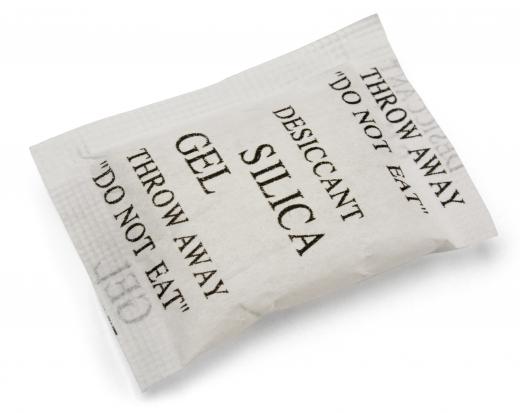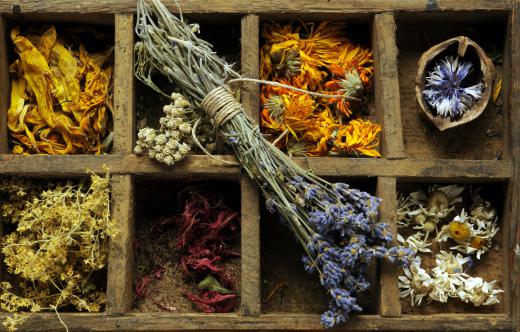What is Silica Gel?
Silica gel is a substance made from silicon silicate that is known for its ability to absorb and hold in moisture. Even though the term silica gel is used to describe this particular type of silica substance, it is actually a solid rather than a gel. This silica is broken up into tiny beads or powder and is often used to draw in moisture from food products or items where excess moisture would be detrimental to the quality of the product. Many consumers find small packets of this sand-like substance inside leather products, pepperoni, and occasionally electronics. Some companies also put packets of the gel inside vitamins to prevent excess moisture from forming inside the capsules or pills.
The maximum amount of moisture that silica gel can absorb is roughly 40 percent of its total weight. Many people would probably guess that once silica gel has absorbed the maximum amount of moisture possible that it would be useless. Silica gel can actually be reused multiple times. To reuse this gel, it needs to be reheated to approximately 300 degrees F (150 C). Reheating the gel to this temperature dries up the moisture it has absorbed so that it can be used again.

Some people use silica gel for the purpose of drying out flowers. This method is often time-consuming, but many people prefer it over other types of flower preservation methods because the results tend to be better when silica gel is used. There is a type of silica called silica sand that is often used specifically for drying out flowers. People normally place their flowers inside an airtight container along with the silica sand for a short length of time. Silica sand wicks away moisture from inside flowers to keep them from drooping and losing their color.

Contrary to popular belief, silica gel is not actually toxic. Many people are under the impression that the gel is toxic because the packets that contain it often have labels on them that say, "Do not eat." Even though gel made from silica isn't considered toxic, people should avoid eating it because it could cause some digestive and respiratory upset. The gel could also become toxic depending on what it has absorbed. For example, if the silica was placed inside of a container that held some type of poisonous substance or a prescription medication that wasn't appropriate for everyone, eating the gel could be life-threatening because it might contain trace amounts of the poison or medicine.
AS FEATURED ON:
AS FEATURED ON:













Discussion Comments
I use the packets to keep garden seeds dry when storing.
@malmal and gimbell - Hey guys, thanks a bunch for the feedback! I'm not sure the silica gel sachets -- or packets, or packs, whatever you want to call them -- will work as well as the loose silica gel "sand" particles, but I can give it a try.
Thanks for the advice on which silica gel sachets to use. You're right, vitamin C pill bottle ones would be just perfect!
I have one more question before I go give this a try. According to the article, you can re-use the silica gel sachets over and over if you heat them up. My question is, can you do that by heating them in the microwave? The tutorials on drying flowers with the loose gel say to use the microwave, so it should work in theory.
@gimbell - That's a really interesting idea, reusing the silica packs. With them in the packets like that you would avoid any silica gel ingestion since the gel particles would be sealed inside the packet. You could make sure they were non-toxic by using ones that you found in food products, too.
I would recommend using the packets you find in vitamins instead of the ones in pepperoni -- the flavor of vitamin C ought to go with your rose hips perfectly already, considering how much vitamin C is in rose hips, and the vitamin silica packs definitely won't add any pepperoni flavor.
@hanley79 - I don't know if I would use the loose silica gel to dry something you're planning on eating or drinking, since you might miss a few pieces when you remove them from the silica gel particles and then you could end up eating them and irritating your stomach.
The little silica gel packs you find in stuff like pepperoni might work, though. I had no idea you could reuse those things -- a very interesting point the article made, there. What if you took silica gel packs from a food product, like pepperoni, and dried them out so get the pepperoni moisture out, then used that for your rose petals and rose hips?
I wonder if they would taste like pepperoni, or if that would go away when the moisture did...pepperoni smell's pretty persistent, it could make your tea taste nasty. Trying it is probably the only way to find out.
Okay, I had heard of silica packets, and I knew they sucked moisture out, but I didn't know they were non-toxic. Cool.
The coolest part about this article for me, though, is the part where it talks about drying flowers using silica sand. I've tried drying rose petals by leaving them out in the sun and they turned all brown -- this is the method I've been looking for to do it right!
Since the silica packets are non-toxic, this would be a particularly good way to dry rose petals for tea. I wonder how deep the silica salt can drain moisture from things? Would it work on something like rosehips?
I have to replace my purse about once every two years, and when I buy a new one, I usually find a silica gel packet inside. I always thought it strange that the packet said, “Do not eat,” because who would want to?
I didn’t know what silica gel was until reading this, so I always washed my hands after touching the packet. I thought it could be poisonous or cause skin irritation.
I knew that silica gel served to preserve products in some way, but I didn’t know it was by absorbing moisture. You wouldn’t think that something trapped inside of a paper packet could do this.
I recently took my dog to the vet and got some tablets to treat her incontinence. The tablets are chewable and flavored, and the bottle contained a silica gel packet. I left it in there, because I didn’t know exactly why it needed to be there. Now I’m glad I did. It will keep the tablets fresh.
Post your comments